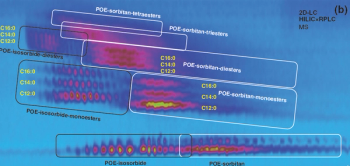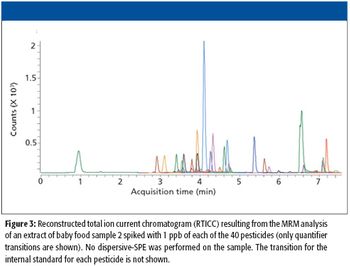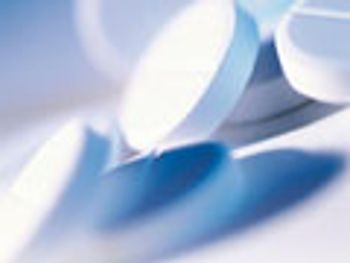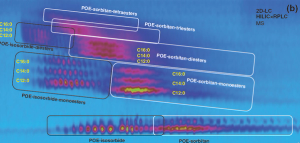
An overview of different approaches for the qualitative and quantitative analysis of polysorbates.
Gerd Vanhoenacker is a senior scientist at RIC group.

An overview of different approaches for the qualitative and quantitative analysis of polysorbates.

An overview of different approaches for the qualitative and quantitative analysis of polysorbates.

This article details a recent experiment that demonstrates how nonspecific interactions can be prevented by using metal-free or low adsorption flow paths.

This article explores potential pitfalls associated with 1D‑LC and how 2D‑LC can overcome these obstacles.

Online 2D-LC is a powerful—and accessible—tool for analyzing pharmaceutical and biopharmaceutical samples, in both R&D and QC. It’s now easier than ever to develop 2D-LC methods, and they can be run in a fully automated manner.

Comprehensive two-dimensional liquid chromatography (2D-LC) was used for detailed profiling of various nonionic ethoxylated surfactants applied in pharmaceutical formulations. Hydrophilic-interaction chromatography (HILIC) and reversed-phase liquid chromatography (LC) were used as the first and second dimensions, respectively. Detection was performed with evaporative light-scattering detection (ELSD) for general profiling and with single-quadrupole mass spectrometry (MS) for structure elucidation of individual peaks and for class-type confirmation of peak-groups.

Comprehensive 2D-LC using HILIC and reversed-phase LC is a robust tool to characterize nonionic ethoxylated surfactants in pharmaceutical formulations.

Two-dimensional liquid chromatography (2D-LC) has in recent years seen an enormous evolution, and with the introduction of commercial instrumentation, the technique is no longer considered a specialist tool. One of the fields where 2D-LC is being widely adopted is in the analysis of biopharmaceuticals, including monoclonal antibodies (mAbs) and antibody–drug conjugates (ADCs). These molecules come with a structural complexity that drives state-of-the-art chromatography and mass spectrometry (MS) to its limits. Using practical examples from the authors’ laboratory complemented with background literature, the possibilities of on-line 2D-LC for the characterization of mAbs and ADCs are presented and discussed.

On-line two-dimensional liquid chromatography (2D-LC) embracing mainly comprehensive LC (LC×LC) and multiple heart-cutting LC (mLC–LC) offers new opportunities for in-depth characterization of pharmaceuticals. Reversed-phase LC × reversed-phase LC using different column chemistries and mobile phases provides good orthogonality for a wide range of applications related to small molecule drugs. Moreover, hardware configurations and software are now commercially available to perform LC×LC and mLC–LC measurements in a reproducible manner.

Analysis of additives such as sweeteners, preservatives, and caffeine in various food products, beverages, and consumer toothpaste using the Agilent 1290 Infinity II LC.

Analysis of additives such as sweeteners, preservatives, and caffeine in various food products, beverages, and consumer toothpaste using the Agilent 1290 Infinity II LC.

PAHs were determined in a petroleum vacuum distillation residue using the Agilent 1290 Infinity Multiple Heart-Cutting 2D-LC solution with normal-phase in the first dimension and reversed-phase in the second dimension.

PAHs were determined in a petroleum vacuum distillation residue using the Agilent 1290 Infinity Multiple Heart-Cutting 2D-LC solution with normal-phase in the first dimension and reversed-phase in the second dimension.

In this application the Agilent 1290 Infinity II LC was used to determine the bitter compounds iso-alpha-acids and reduced iso-alpha-acids, and the clove-like phenolic flavor 4-vinylguaiacol in bottled beer.

In this application the Agilent 1290 Infinity II LC was used to determine the bitter compounds iso-alpha-acids and reduced iso-alpha-acids, and the clove-like phenolic flavor 4-vinylguaiacol in bottled beer.

This Application Note describes the method transfer of a USP HPLC method for amlodipine besylate tablets to a UHPLC method using the Agilent 1290 Infinity II LC.

This Application Note describes the method transfer of a USP HPLC method for amlodipine besylate tablets to a UHPLC method using the Agilent 1290 Infinity II LC.

The determination of genotoxic impurities (GIs) in drug substances and pharmaceutical products is an emerging topic in pharmaceutical quality control. GIs are intermediates or reactants in the synthetic pathway of a drug substance and should be monitored at ppm (?g/g drug substance) or even ppb (ng/g) levels. This is several orders of magnitude lower than in classical impurity analysis (0.05% or 500 ppm level) or in residual solvent analysis. Analytical methods for the determination of GIs include gas chromatography (GC) and liquid chromatography (LC), both often combined with mass spectrometry (MS) detection. Some typical examples of GIs trace analysis using GC and LC are presented. The potential of on-line reaction monitoring is also discussed.

A simple experimental setup applied in a drug discovery laboratory illustrates some anomalies and misconceptions about supercritical fluid chromatography for drug discovery.

Discussing the latest developments in sample preparation techniques that reduce environmental impact.

The safety of the food that our children eat is a global concern. Regulations are in place that limit the maximum level of pesticides that can be present in food meant for children, and methods to detect levels well below those limits are needed to ensure the safety of the food supply. Combining the speed and separation efficiency of ultrahigh-pressure liquid hromatography (UHPLC) with the sensitivity and selectivity of triple-quadrupole mass spectrometry (MS)-MS results in a method that can deliver ultralow quantification of pesticides in baby food, with limits of detection more than an order of magnitude below the allowed maximum levels.

Part one focusses on ways of reducing and replacing solvents commonly used as mobile phases

This article describes methods to quantitatively analyse genotoxic and potentially genotoxic impurities in pharmaceutical ingredients

In general, polymer-based columns have a broad pH range (pH 2 to 13), and some have high temperature tolerance (up to 150°C or higher). Considerably large selectivity changes can be obtained by varying analysis temperature and mobile phase pH. Having control on these two parameters over wide ranges can be especially useful in method development.

An overview is presented of possible pathways to enhance peak capacity in liquid chromatography (LC). The peak capacity in a chromatographic separation is directly related to the plate number and thus to column length and particle size. Serial coupled columns can be used to obtain long effective column lengths, reaching over 100000 theoretical plates and peak capacities up to 900. Some theoretical considerations are made on column dimensions and particle size and examples are given of high resolution "GC-like" separations in LC using state-of-the-art LC hardware. Recent developments in LC hardware have also enhanced the applicability of two-dimensional LC–LC and comprehensive LCÃ-LC. Both techniques are extremely powerful to unravel complex samples.

Published: August 1st 2023 | Updated:

Published: January 6th 2025 | Updated:

Published: September 1st 2022 | Updated:

Published: September 1st 2022 | Updated:

Published: May 2nd 2013 | Updated: